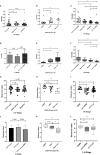Characteristics of T-Cell Receptor Repertoire and Correlation With EGFR Mutations in All Stages of Lung Cancer
- PMID: 33777727
- PMCID: PMC7991722
- DOI: 10.3389/fonc.2021.537735
Characteristics of T-Cell Receptor Repertoire and Correlation With EGFR Mutations in All Stages of Lung Cancer
Abstract
Lung cancer is the leading cause of cancer-related deaths worldwide, and its occurrence is related to the accumulation of gene mutations and immune escape of the tumor. Sequencing of the T-cell receptor (TCR) repertoire can reveal the immunosurveillance status of the tumor microenvironment, which is related to tumor escape and immunotherapy. This study aimed to determine the characteristics and clinical significance of the TCR repertoire in lung cancer. To comprehensively profile the TCR repertoire, results from high-throughput sequencing of samples from 93 Chinese patients with lung cancer were analyzed. We found that the TCR clonality of tissues was related to smoking, with higher clonality in patients who had quit smoking for less than 1 year. As expected, TCR clonality was correlated with stages: patients with stage IV disease showed higher clonality than others. The correlation between TCR repertoire and epidermal growth factor receptor (EGFR) status was also investigated. Patients with EGFR non-L858R mutations showed higher clonality and a lower Shannon index than other groups, including patients with EGFR L858R mutation and wild-type EGFR. Furthermore, we analyzed the TCR similarity metrics-that is, the TCR shared between postoperative peripheral blood and tissue of patients with non-distant metastasis of lung cancer. A similar trend was found, in which patients with EGFR L858R mutations had lower overlap index (OLI) and Morisita index (MOI) scores. Moreover, the OLI showed a positive correlation with several clinical characteristics, including the tumor mutational burden of tissues and the maximum somatic allele frequency of blood; OLI showed a negative correlation with the ratio of CD4+CD28+ in CD4+ cells and the ratio of CD8+CD28+ in CD8+ cells. In conclusion, TCR clonality and TCR similarity metrics correlated with clinical characteristics of patients with lung cancer. Differences in TCR clonality, Shannon index, and OLI across EGFR subtypes provide information to improve understanding about varied responses to immunotherapy in patients with different EGFR mutations.
Keywords: T-cell receptor repertoire; clonality; epidermal growth factor receptor; high-throughput sequencing; lung cancer.
Copyright © 2021 Yang, Wang, Jia, Wang, Yang, Wu, Song, Xu, Gu, Chen, Xia, Bing, Gao, Cao, Li, Cao and Liang.
Conflict of interest statement
DG, RC, and XX are employees of Geneplus-Beijing Ltd. The remaining authors declare that the research was conducted in the absence of any commercial or financial relationships that could be construed as a potential conflict of interest.
Figures





Similar articles
-
Comprehensive analysis of T cell receptor repertoire in patients with KRAS mutant non-small cell lung cancer.Transl Lung Cancer Res. 2022 Sep;11(9):1936-1950. doi: 10.21037/tlcr-22-629. Transl Lung Cancer Res. 2022. PMID: 36248331 Free PMC article.
-
A high density of tertiary lymphoid structure B cells in lung tumors is associated with increased CD4+ T cell receptor repertoire clonality.Oncoimmunology. 2015 Jun 1;4(12):e1051922. doi: 10.1080/2162402X.2015.1051922. eCollection 2015 Dec. Oncoimmunology. 2015. PMID: 26587322 Free PMC article.
-
3D: diversity, dynamics, differential testing - a proposed pipeline for analysis of next-generation sequencing T cell repertoire data.BMC Bioinformatics. 2017 Feb 27;18(1):129. doi: 10.1186/s12859-017-1544-9. BMC Bioinformatics. 2017. PMID: 28241742 Free PMC article.
-
Evaluation of the TCR Repertoire as a Predictive and Prognostic Biomarker in Cancer: Diversity or Clonality?Cancers (Basel). 2022 Mar 31;14(7):1771. doi: 10.3390/cancers14071771. Cancers (Basel). 2022. PMID: 35406543 Free PMC article. Review.
-
Tyrosine kinase inhibitors for epidermal growth factor receptor gene mutation-positive non-small cell lung cancers: an update for recent advances in therapeutics.J Oncol Pharm Pract. 2016 Jun;22(3):461-76. doi: 10.1177/1078155215577810. Epub 2015 Apr 8. J Oncol Pharm Pract. 2016. PMID: 25855240 Review.
Cited by
-
EGFR Status Assessment for Better Care of Early Stage Non-Small Cell Lung Carcinoma: What Is Changing in the Daily Practice of Pathologists?Cells. 2021 Aug 21;10(8):2157. doi: 10.3390/cells10082157. Cells. 2021. PMID: 34440926 Free PMC article. Review.
-
Clonal expansion of shared T cell receptors reveals the existence of immune commonality among different lesions of synchronous multiple primary lung cancer.Cancer Immunol Immunother. 2024 Apr 26;73(6):111. doi: 10.1007/s00262-024-03703-8. Cancer Immunol Immunother. 2024. PMID: 38668781 Free PMC article.
-
Genomic, transcriptomic, and T cell receptor profiling in stratifying response to first-line chemoradiotherapy or radiotherapy for esophageal squamous cell carcinoma.Front Oncol. 2025 Jan 6;14:1495200. doi: 10.3389/fonc.2024.1495200. eCollection 2024. Front Oncol. 2025. PMID: 39834937 Free PMC article.
-
Liquid biopsy using ascitic fluid and pleural effusion supernatants for genomic profiling in gastrointestinal and lung cancers.BMC Cancer. 2022 Sep 27;22(1):1020. doi: 10.1186/s12885-022-09922-5. BMC Cancer. 2022. PMID: 36167530 Free PMC article.
-
Genomic and T cell repertoire biomarkers associated with malignant mesothelioma survival.Thorac Cancer. 2024 Jul;15(19):1502-1512. doi: 10.1111/1759-7714.15326. Epub 2024 May 27. Thorac Cancer. 2024. PMID: 38798202 Free PMC article.
References
-
- Brahmer JR, Rodriguez-Abreu D, Robinson AG, Hui R, Csoszi T, Fulop A, et al. . Health-related quality-of-life results for pembrolizumab versus chemotherapy in advanced, PD-L1-positive NSCLC (KEYNOTE-024): a multicentre, international, randomised, open-label phase 3 trial. Lancet Oncol (2017) 18:1600–9. 10.1016/s1470-2045(17)30690-3 - DOI - PubMed
Associated data
LinkOut - more resources
Full Text Sources
Other Literature Sources
Research Materials
Miscellaneous

